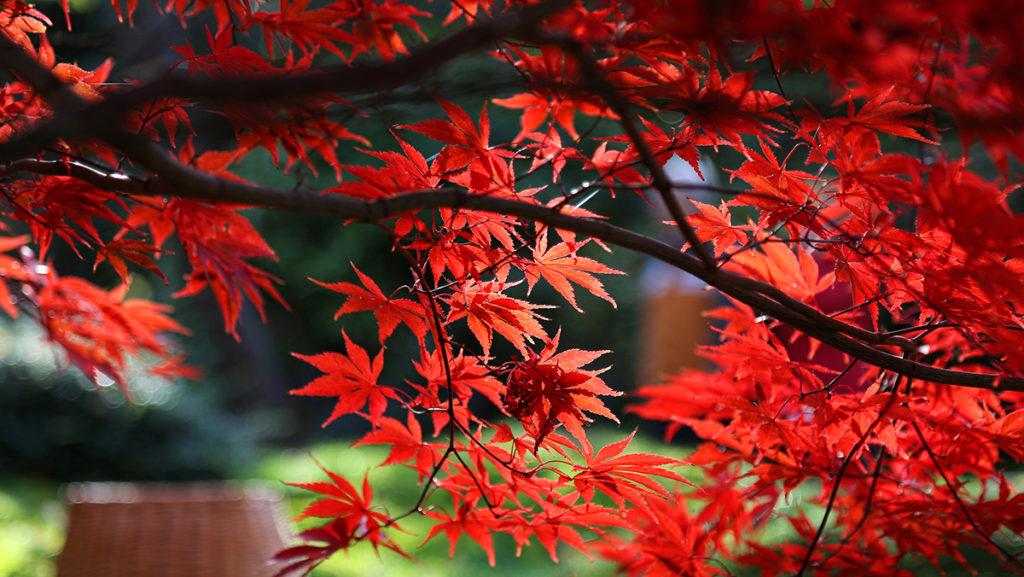Graceful and elegant, Japanese maples (Acer palmatum) are an excellent addition to most gardens. Essentially carefree once established, they offer year-round interest with their ever-changing beauty. From the sculpture of bare winter branches to the flush of spring leaves in colors of red, pink, or green. Followed by lush summer growth, and finally, a big finish in the fall. They're one of the most compelling plants you can add to your landscape. (Or terrace, patio, or courtyard, too-remember, some can grow in large pots).
To figure out which maple is right for your garden, consider these four factors:
Zone: Most Japanese maples do well in zones 5 – 8. They can be grown in warmer zones, but can suffer from leaf scorch. They require ample regular summer irrigation and protection from hot afternoon sun. In Zone 4, most Japanese maples (except for Velvet Viking™) are not reliable in the garden. It's possible for them to survive a year or two if the winter lows aren't too severe. Although, sooner or later, they will succumb to weather. They can, however, be grown in containers and, once dormant, overwintered in an unheated garage or other cool, sheltered location. A better option might be a Korean maple which is lovely and hardy to zone 4.
Size and Form: Choosing the right one means knowing how you want to use it. Japanese maples range from 2 to 30 feet tall in forms that can be weeping, rounded, dwarf, mounding, upright, or cascading. Are you looking to create a grove of Japanese maples? Maybe create a spotlight with a solitary specimen? Do you want to fill a large container? Or perhaps a taller Japanese maple as the main attraction?
Leaf Shape: Decide which type of foliage appeals to you. Once you’ve got the size and form figured out, think about foliage. Japanese maple foliage is primarily divided into two types: either palm-shaped (Acer palmatum), or delicate and lacy (Acer palmatum var. dissectum). There are fans of both types. The choice is often informed by the style of the garden or the surrounding structures.
Leaf Color: What color of foliage appeals most? With a range of foliage colors, Japanese maples are among the most colorful of trees. (Colors such as red, green, orange, purple, white, and pink depending on the season.) Some leaf out in brilliant reds in spring and change to green by summer. Then finish the fall in yellows and oranges. Others start red and stay red till autumn. Do you want a sequence of changing color from spring to fall? Or, do you just really love rich, dramatic red throughout the seasons?
Once you have a handle on these considerations, it’s time to see some options! It's always best to visit your local garden center. You'll get the best possible information on what grows very well in your specific region.
To get you started here are some of our favorite Japanese maples divided by size. Also some suggested ways to use them as well as care and planting info.
Best Japanese Maples for Small Spaces and Containers
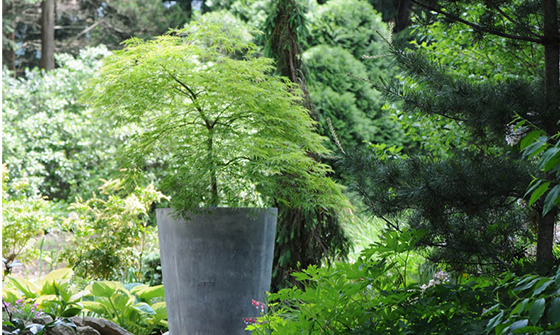
Some Japanese maples are naturally dwarf. Or, grafted onto rootstock that keeps them small for years (even decades if you're into pruning). Or, simply very slow-growing. These offer the opportunity to have a spectacular specimen. One that you can grow in a container or in a confined space. Choose carefully and avoid issues later. Do so by only selecting those that max out at no more than 10 ft. tall and wide at maturity.

Shaina Japanese Maple
Zone: 5 – 8
Dwarf, compact form that becomes dense with maturity. New foliage emerges bright red, aging to deep maroon. Partial shade to full sun. Up to 8 ft. tall and wide.
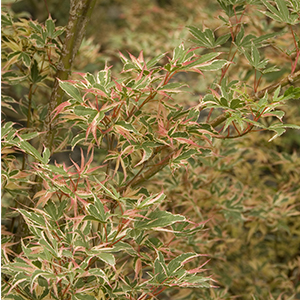
Kagiri Nishiki Japanese Maple
Zone: 5 – 8
Unique pink and white irregular border on the light green leaves. Slow-growing it’s ideal for smaller courtyards. Partial shade to full sun. Up to 8 ft. tall and 4 ft. wide.
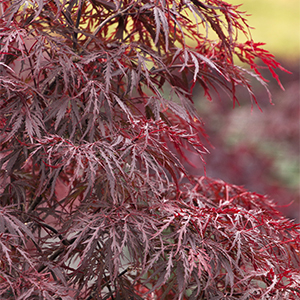
Red Dragon Japanese Maple
Zone: 5 – 8
Beautiful, deeply dissected purple leaves turn bright apple red in fall. Slow growing and perfectly sized for containers. Partial to full sun. Up to 5 ft. tall and wide.
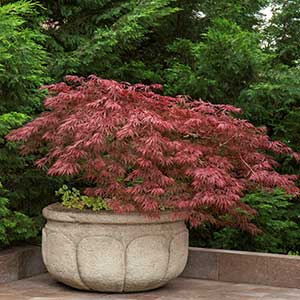
Velvet Viking™ Japanese Maple
Zone: 4 – 9
The hardiest Japanese Maple we have seen, it features finely cut red-purple foliage throughout the spring and summer months. It becomes richer in autumn. In most areas, it prefers partial shade, but in cool-summer areas it can take full sun. Up to 4 feet tall and 5 feet wide.
Best Japanese Maples for Grouping or Statement
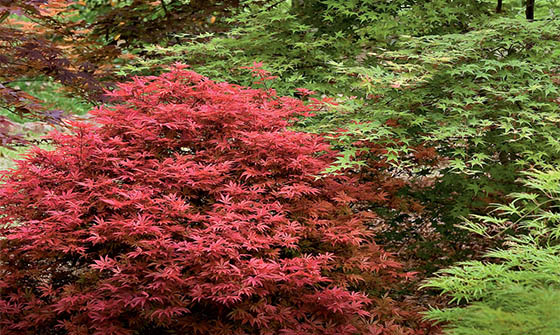
While we often see them carefully situated as stand alone specimens, especially in Asian-inspired gardens. In the wild Japanese maples grow in groups as understory plants in shady woodland spaces. You can get the same effect in your own garden by mixing several different types, shapes, and sizes. Ranging from about 10 ft. tall and above. While each will need ample room to grow, plant close enough so their branches can intermix. Magic!
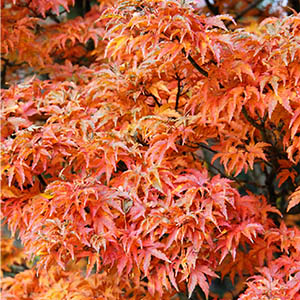
Shishigashira Japanese Maple
Zone: 5 – 8
Heavily curled foliage becomes purple-red with orange-red patterns in fall. Less likely to sunburn than other varieties. Partial to full sun. Up to 15 ft. tall and 10 ft. wide.
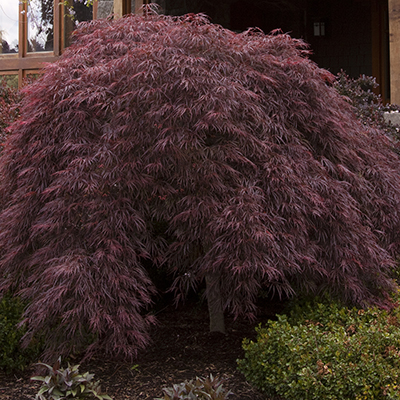
Crimson Queen Japanese Maple
Zone: 5 – 8
Low-branching, dwarf tree with delicate, weeping form and beautiful crimson summer color turning scarlet in fall. Partial to full sun. Up to 10 ft. tall and wide.
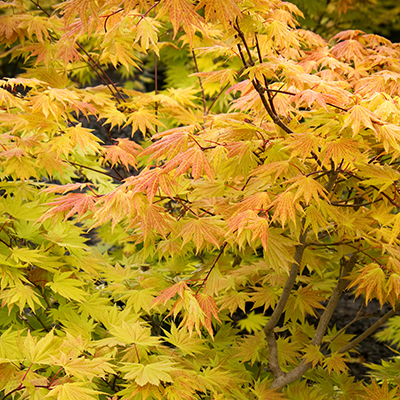
Autumn Moon Fullmoon Maple Zone: 5 – 7
Outstanding for limited spaces. New growth unfurls yellow to burnt orange, with exceptional fall foliage. Partial shade to partial sun. Up to 10 ft. tall and wide.
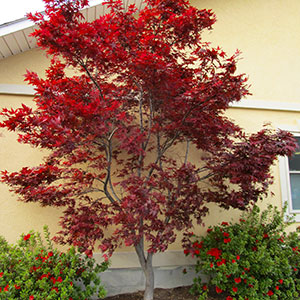
Emperor I® Japanese Maple
Zone: 5 – 8
A stunning statement plant, it shows off dark red-purple foliage that turns brilliant shades of scarlet come fall. It is slow to leaf out in spring, protecting it from late spring frosts. Partial to full sun. Up to 15 feet tall and wide.
Best Japanese Maples for One Big WOW
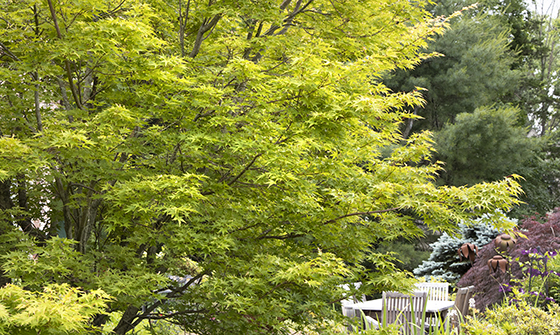
If you have a spot that needs both height and drama, maybe try a Japanese maple. One that tops at about 25 ft. tall. This might be just what you're looking for. While still relatively small as trees go, they're big on the wow factor. This is due to their shape, foliage, bark, or often all of the above. These three are best used where they can stand alone without other trees or large shrubs competing for attention. As with all trees, pay careful attention to mature size. (This is Coral Bark Japanese Maple in the summer.)

Bloodgood Japanese Maple
Zone: 5 – 8
Foilage opens red, turns brilliant-scarlet in fall, and blackish-red bark is a winter standout. Excellent small lawn tree. Filtered to full sun. Up to 20 ft. tall and 15 ft. wide.

Coral Bark Japanese Maple
Zone 5 – 8
Year-round showstopper with vibrant fall foliage and unique brilliant red-coral bark on young branches even in winter. Filtered to full sun. Up to 25 ft. tall and 20 ft. wide.
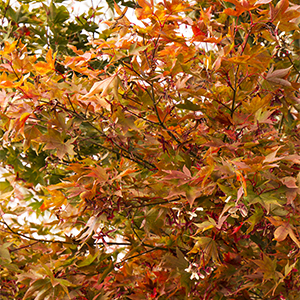
Osakazuki Japanese Maple
Zone: 5 – 8
Bright green summer leaves become brilliant crimson red in fall, holding color for several weeks. Lovely specimen tree. Partial to full sun. Up to 25 ft. tall and wide.
Japanese maple care tips
- While some can tolerate full sun, most Japanese maple varieties prefer dappled or afternoon shade, especially when young. Shade does have its limits though. They need some sun for best foliage color. Also to promote the more loose and open structure for which they are prized.
- Protection from strong winds.
- Well-drained, consistently moist soil–during extreme heat or drought, give them a little extra water.
- Protection from late spring frosts, especially when young.




